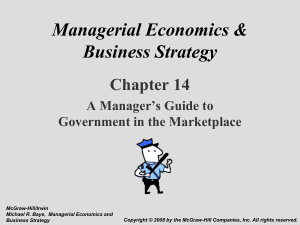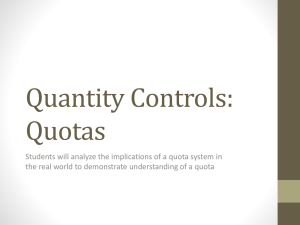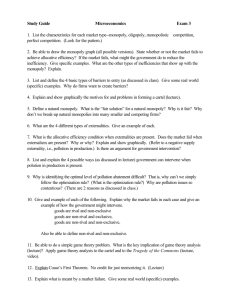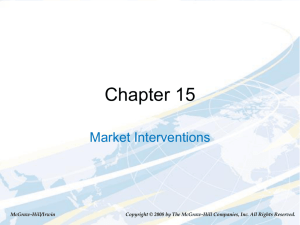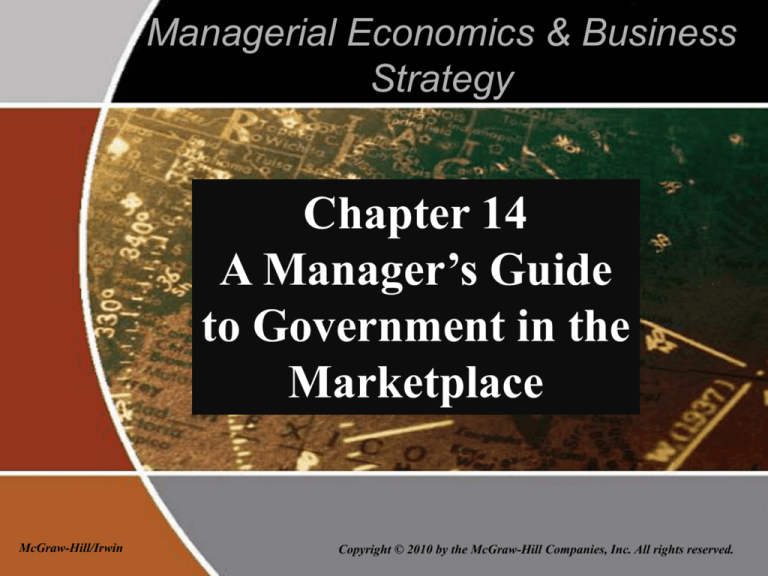
Managerial Economics & Business
Strategy
Chapter 14
A Manager’s Guide
to Government in the
Marketplace
McGraw-Hill/Irwin
Copyright © 2010 by the McGraw-Hill Companies, Inc. All rights reserved.
Government Regulations
Government regulations affect most
decisions that consumers and firms make.
Legitimate reasons for government
intervention:
Market Power
Externalities
Public Goods
Asymmetric Information
14-2
Government Regulations
Government Policy and International Markets
– Quotas
– Tariffs
14-3
Market Power
Firm produces a level of output less than is
socially efficient and charges a price higher
than marginal cost.
Net gain to society if more output were
produced.
Government can intervene to increase
social welfare.
14-4
Market Power
Market power is the ability
of a firm to set P > MC.
Firms with market power
produce socially inefficient
output levels.
– Too little output
– Price exceeds MC
– Deadweight loss
P
Deadweight
Loss
MC
PM
PC
MC
• Dollar value of society’s
welfare loss
D
QM
QC
MR
Q
14-5
Antitrust Policies
Administered by the DOJ and FTC
Goals:
– To eliminate deadweight loss of monopoly and
promote social welfare.
– Make it illegal for managers to pursue strategies
that foster monopoly power.
14-6
Sherman Act (1890)
Sections 1 and 2 prohibits price-fixing,
market sharing and other collusive
practices designed to “monopolize, or
attempt to monopolize” a market.
14-7
United States v. Standard Oil of New Jersey
(1911)
Charged with attempting to fix prices of
petroleum products. Methods used to enhance
market power:
– Physical threats to shippers and other
producers.
– Setting up artificial companies.
– Espionage and bribing tactics.
– Engaging in restraint of trade.
– Attempting to monopolize the oil industry.
14-8
United States v. Standard Oil of New Jersey
(1911)
Result 1: Standard Oil dissolved into 33
subsidiaries.
Result 2: New Supreme Court Ruling the rule of
reason.
– Stipulates that not all trade restraints are
illegal, only those that are unreasonable are
prohibited.
Based on the Sherman Act and the rule of
reason, how do firms know a priori whether a
particular pricing strategy is illegal?
Clayton Act (1911) and Robinson-Patman (1936)
14-9
Clayton Act (1914)
Makes hidden kickbacks (brokerage fees)
and hidden rebates illegal.
Section 3 Prohibits exclusive dealing and
tying arrangements where the effect may
be to “substantially lessen competition.”
14-10
Cellar-Kefauver Act (1950)
Amends Section 7 of Clayton Act.
Strengthens merger and acquisition policies.
Horizontal Merger Guidelines
– Market Concentration
• Herfindahl-Hirschman Index: HHI = 10,000 S wi2
• Industries in which the HHI exceed 1800 are
generally deemed “highly concentrated”.
• The DOJ or FTC may, in this case, attempt to
block a merger if it would increase the HHI by
more than 100.
14-11
DOJ Flexibility
Mergers are often allowed even when HHI
is large provided there is likelihood of entry
of domestic or foreign firms, increased
efficiency, or a firm has financial problems.
14-12
Regulating Monopolies
When large economies of scale exist it
may be that one firm can more efficiently
service the market.
Government can sanction the monopoly
but will regulate prices to reduce
deadweight loss.
14-13
Regulating Monopolies:
Marginal-Cost Pricing
P
MC
PM
PC
Effective Demand
MR
QM
QC
Q
14-14
Problem 1 with Marginal-Cost
Pricing: Possibility of ATC > PC
P
MC
PM
ATC
PC
ATC
MR
QM
QC
Q
14-15
Price Regulation
If regulated price is set at too low a level
then the social cost of regulation is greater
then the social cost of allowing the firm to
price as a monopoly.
Next graph indicates this scenario.
14-16
Problem 2 with Marginal-Cost
Pricing: Requires Knowledge of
MC
P
Deadweight loss
after regulation
MC
PM
Deadweight loss
prior to regulation
PReg
Effective Demand
MR
QReg QM
Q*
Q
Shortage
14-17
Externalities
A negative externality is a cost borne by
people who neither produce nor consume
the good.
Example: Pollution
– Caused by the absence of well-defined
property rights.
Government regulations may induce the
socially efficient level of output by forcing
firms to internalize pollution costs
– The Clean Air Act of 1970.
14-18
Methods for Dealing with Negative
Externalities
Command and Control methods
Market based alternatives
– Pigouvian Tax
– Pollution Permit System (cap and trade)
– Coase
14-19
Socially Efficient Equilibrium:
Internal and External Costs
P
Socially efficient equilibrium
MC external + internal
PSE
MC internal
PC
MC external
Competitive
equilibrium
D
QSE QC
Q
14-20
Public Goods
A good that is non-rival and non-exclusionary
(excludable) in consumption.
– Non-rival: A good which when consumed by one
person does not preclude other people from also
consuming the good.
• Example: Radio signals, national defense
– Non-exclusionary (excludable): No one is
excluded from consuming the good once it is
provided.
• Clean air
• National defense
• Street lights
14-21
Public Goods
“Free Rider” Problem
– Individuals have little incentive to buy a public
good because of their non-rival & nonexclusionary nature.
– The market has no incentive to provide public
goods because of potential free riders.
– Government provides the public good from tax
monies collected from everyone.
14-22
Public Goods
Benefit-cost analysis is used to determine
whether and how much of a public good to
provide.
Costs are straightforward
Determining benefits poses a problem
14-23
Incomplete Information
Participants in a market that have
incomplete information about prices,
quality, technology, or risks may be
inefficient.
The Government serves as a provider of
information to combat the inefficiencies
caused by incomplete and/or asymmetric
information.
14-24
Government Policies Designed to Mitigate
Incomplete Information
OSHA – full info to workers
SEC – insider trading; 2009 crisis
Certification – minimum standards;
certified charities; schools
14-25
Government Policies Designed to Mitigate
Incomplete Information
Truth in lending –creating more symmetric
information between borrowers and
lenders
Truth in advertising – treble damages
under the Lanham and Clayton Acts
Contract enforcement – deterring
opportunistic behavior.
14-26
Rent Seeking
Government policies will generally benefit
some parties at the expense of others.
Lobbyists spend large sums of money in an
attempt to affect these policies.
This process is known as rent-seeking –
selfishly motivated efforts to influence
another party’s decision.
14-27
An Example:
Seeking Monopoly Rights
Firm’s monetary incentive to
P
lobby for monopoly rights: A
Consumers’ monetary incentive
to lobby against monopoly:
A+B.
PM
Firm’s incentive is smaller than
consumers’ incentives.
C
But, consumers’ incentives are P
spread among many different
individuals.
As a result, firms often succeed
in their lobbying efforts.
Consumer
Surplus
A = Monopoly Profits
B = Deadweight Loss
A
B
MC
D
MR
QM
QC
Q
14-28
Quotas and Tariffs
Quota
– Limit on the number of units of a product that a foreign
competitor can bring into the country.
• Reduces competition, thus resulting in higher prices, lower
consumer surplus, and higher profits for domestic firms.
Tariffs
– Lump sum tariff: a fixed fee paid by foreign firms to enter
the domestic market.
– Excise tariff: a per unit fee on each imported product.
• Causes a shift in the MC curve by the amount of the tariff
which in turn decreases the supply of all foreign firms.
14-29
Analysis of a Tariff on Cotton Shirts
P
free trade
CS = A + B + C
+D+E+F
PS = G
Total surplus = A + B
+C+D+E+F+G
tariff
CS = A + B
PS = C + G
Revenue = E
Total surplus = A + B
+C+E+G
Cotton
shirts
deadweight
loss = D + F
S
A
B
$30
$20
C
D
E
F
G
25
40
70 80
D
Q
14-30
Figure 7 The Effects of an Import Quota
Price
of Steel
Domestic
supply
Equilibrium
without trade
Domestic
supply
+
Import supply
Quota
Isolandian
price with
quota
Equilibrium
with quota
Price
World
without =
price
quota
0
Imports
with quota
Q
S
Q
S
Domestic
demand
Q
Imports
without quota
D
Q
D
World
price
Quantity
of Steel
14-31
Copyright © 2004 South-Western
Conclusion
Market power, externalities, public goods,
and incomplete information create a
potential role for government in the
marketplace.
Government’s presence creates rentseeking incentives, which may undermine
its ability to improve matters.
14-32

